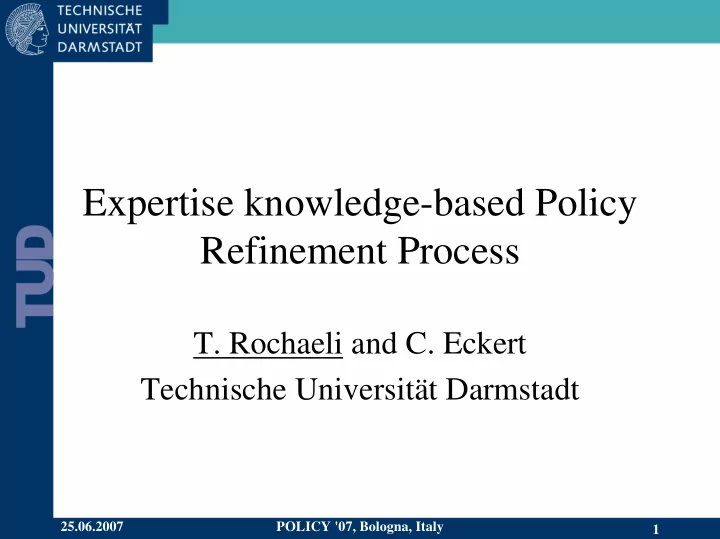

Expertise knowledge-based Policy Refinement Process T. Rochaeli and C. Eckert Technische Universität Darmstadt 25.06.2007 POLICY '07, Bologna, Italy 1
Workflow and Kripke Model • Workflow: computerized facilitation or automation of a business process Submit loan application s1 • Kripke model represents the behavior of workflow – connected directed graph: nodes are states and edges are state transitions Check rating – state: snapshot of the workflow s2 behavior – State transitions: possible next subsequent states Reevaluate application – state labels: occurrence of events (i.e. s3 task execution) Approve application – Formally, M : (W,R,L) s4 – W, set of states R ⊂ W x W, set of state transitions – L: W � 2 AP , labeling function – 25.06.2007 POLICY '07, Bologna, Italy 2
The Gap between Design and Implementation • Caused by the simplification of workflow design – Developer assumption: “Everything is just fine…” Submit loan application s1 User activates role A • Model of workflow design Check rating – Consider only task’s execution s2 • Model of workflow Reevaluate application implementation s3 – any other events could also happen (i.e. role activation, user Approve application s4 authentication) User activates role A • An example of malicious execution path (or trace) Workflow Design Workflow Implementation – Same role activates two sensitive tasks 25.06.2007 POLICY '07, Bologna, Italy 3
State Labels to Represent Security Policy • Avoid the malicious execution path by specifying security policy Apply separation of duty Malicious execution path in the shaded zone: Submit loan application – The security mechanism s1 Apply separation of duty (separation of duty) should be applied within this execution path Check rating s2 Apply separation of duty • The shaded zone is represented by additional states label Reevaluate application s3 • States labels along a fragment of execution path represent the Approve application s4 security policy Apply separation of duty 25.06.2007 POLICY '07, Bologna, Italy 4
Refining the State Labels • Source of the policy refinement process: abstract policies Submit loan application s1 – Originated from stakeholders’ Prevent fraud Apply separation of duty protection intent – Abstract state labels Check rating s2 Apply separation of duty Prevent fraud • Target of the policy refinement process: concrete policies Reevaluate application s3 – Concrete state labels – Denote the execution path, in Grant application which the security mechanism s4 Apply separation of duty Prevent fraud should apply � domain experts’ knowledge • is required! 25.06.2007 POLICY '07, Bologna, Italy 5
Documenting the Experts’ Knowledge • Make use pattern paradigm – A pattern captures the best-practice solution to a problem in a certain context • Three main parts of refinement pattern – Context: describes the execution path, in which the problem occurs – Problem: describes the abstract state labels – Solution: describes the less abstract state labels that should be defined within the context • Formal representation (required for automated refinement process) – All parts of the pattern are represented by Linear-time Temporal Logic formulas • Advantage: – Effective documentation and transfer of knowledge between domain experts • Disadvantage: – The correctness of refined policies depends on the validity of the patterns 25.06.2007 POLICY '07, Bologna, Italy 6
An Overview of Expertise Knowledge-based Policy Refinement Process pattern A pattern B ctx ctx prb prb pattern matching pattern matching sln sln add new label add new label P1 OR P2 P3 Policies represented as tree Policies represented as state labels 25.06.2007 POLICY '07, Bologna, Italy 7
An Overview of Expertise Knowledge-based Policy Refinement Process P1 OR P2 P3 AND AND P4 P6 P7 Policies represented as tree Policies represented as state labels 25.06.2007 POLICY '07, Bologna, Italy 8
Model Checking • Objective – Given a model M and a formula f , retrieve the execution path , which satisfies the formula f – Formally: • Model checking as pattern matching Kripke model M – Pattern context and problem as formula and – Workflow model M – Find any (finite) execution path satisfying: Syntax rule for constructing LTL formula • Main obstacle – Both sets of atomic propositions use different vocabularies 25.06.2007 POLICY '07, Bologna, Italy 9
Description Logic-based Model Checking (I) • Idea: CTL* semantics – emulate the CTL* semantics on top of the Description Logic DL semantics semantics – Use instance checking reasoning DL reasoning engine • Approach – Define ontology of atomic propositions as a common vocabulary between M and f – Define CTL* semantics on top of Linear-time description logic semantics CTL Temporal Logic (LTL) – Represent M as individual (instance) assertions CTL* – Represent f as concepts (classes) – Perform instance checking 25.06.2007 POLICY '07, Bologna, Italy 10
Description Logic-based Model Checking (II) • Translated query: M, σ 0 ² f ? � : KB ² C(x) ? • Legend: – M : Kripke model σ 0 : first state of the path – – f : temporal logic formula – KB: knowledge base – C : concept representing f – x : instance representing σ 0 • Informally: – Does the path starting from state σ 0 of model M fulfill the formula f ? � – Based on knowledge base KB, is the instance x a member of concept C? 25.06.2007 POLICY '07, Bologna, Italy 11
Contributions • Automated policy refinement process by using expertise knowledge • Capturing the expertise knowledge using formalized patterns – Effectively capture domain experts’ knowledge pertaining to workflow security (finance, healthcare, government, etc.) – The experts’ knowledge can be directly used by the automated refinement process • Description logic-based model checking – Enable model checking in heterogeneous environment (i.e. compliance check of web services behavior against customer policy) 25.06.2007 POLICY '07, Bologna, Italy 12
13 POLICY '07, Bologna, Italy Thank you! End 25.06.2007
Recommend
More recommend